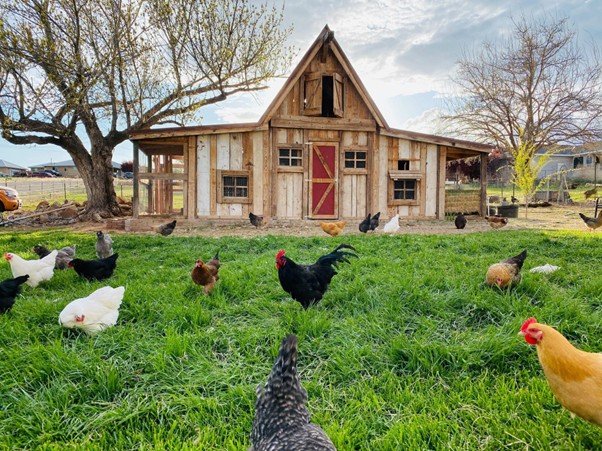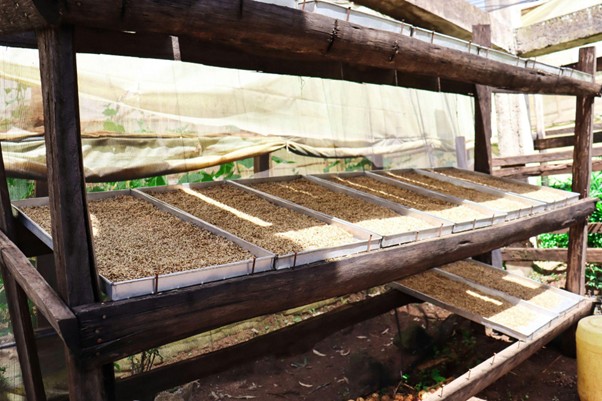How to Grow Fodder for Chickens: A Guide for Poultry Farmers

Growing your own fodder for chickens is an easy and cost-effective way to provide fresh, nutrient-rich feed year-round. In the USA, popular choices like barley, wheat, oats, and millet are ideal for poultry fodder because they're highly digestible, packed with vitamins and minerals, and easy to source locally.
To grow fodder for chickens, you can use a hydroponic or tray system, a soilless method that uses water and nutrient solutions to sprout grains. In just a few days, the seeds grow into lush, green feed that can enhance egg quality, boost immunity, and support overall flock health.
What is Chicken Fodder and Why It Matters

Chicken fodder is a simple and inexpensive feed made from whole grains such as barley, wheat, oats, and millets. The process is simple: soak the seeds, rinse them daily, and place them in a tray to grow, usually for about a week or so until they reach a height of 3-4 inches.
Chicken fodder is nutrient-rich; it is high in protein, vitamins, minerals, and enzymes, and is more digestible for chickens. It provides fresh greens to chickens when pasture is limited, such as during winter or drought.
However, chicken fodder is not the main diet for poultry. It's a great supplement, not a complete feed replacement. On its own, it cannot provide all the energy, protein, and minerals that chickens need for sustained growth and egg production.
Here's what an ideal balanced feed for chickens looks like:
- Balanced Commercial Feed (Main Diet): This should make up about 70–80% of their diet. Layer or broiler feed is formulated with the right mix of protein, energy, calcium, and vitamins for their specific needs.
- Fodder (Fresh Greens): Include 10–20% sprouted grains or hydroponic fodder. It provides enzymes, protein, and vitamins that support digestion and overall health.
- Scratch Grains or Whole Grains: Small amounts of cracked corn, wheat, or millet provide energy and keep chickens active while foraging.
- Protein Supplements: Options like soybean meal, fish meal, or mealworms are excellent for growth, especially in laying hens and broilers.
- Minerals & Grit: Provide free-choice calcium (crushed oyster shells) and grit to aid digestion and strengthen eggshells.
- Clean Water: Fresh, clean water should be available at all times. It's often overlooked but essential for digestion and egg production.
- Kitchen Scraps/Waste: Safe vegetable peels, leafy greens, rice, or fruit scraps can be fed in moderation. Avoid moldy, salty, or greasy food, as well as avocado, chocolate, and onion, which are harmful to chickens.
Importance of Growing Fodder for Chickens

Growing fodder for chickens involves sprouting grains like barley, wheat, oats, or millet into nutrient-rich greens that can be fed directly to poultry. This process is often done using hydroponic or tray systems, where seeds grow without soil, using only water and light.
The result is a lush, living feed that's rich in vitamins, enzymes, and fiber.
Fodder is an excellent supplement to commercial feed. It's a sustainable, low-cost way for farmers to improve flock nutrition, especially when fresh pasture isn't available year-round.
Key Benefits of Growing Fodder for Chickens
- Improves Egg Quality: Enhances yolk color, shell strength, and nutrient content.
- Boosts Immunity: Provides natural vitamins, minerals, and enzymes that strengthen disease resistance.
- Supports Digestion: Fresh greens add fiber and aid in better nutrient absorption.
- Reduces Feed Costs: Homegrown fodder can lower dependence on commercial feed.
- Eco-Friendly Option: Uses less water, requires no soil, and reduces waste.
- Encourages Natural Foraging: Keeps chickens active and mimics their natural pecking behavior.
Best Fodder for Chicken Nutrition
Here are the top high-nutrition fodder seeds that can aid your chicken's growth and productivity.
Choosing the Right Fodder Mix for Chickens
The best fodder mix depends on your production goals. Whether you're raising chickens for eggs, meat, or general flock health. Combining different grains ensures a balanced nutrient profile with the right mix of protein, energy, and fiber.
- For Laying Hens: A mix of alfalfa and barley provides calcium, protein, and vitamins essential for stronger eggshells and higher egg yield.
- For Meat Birds (Broilers): Combine field peas and wheat to support rapid growth, muscle development, and efficient feed conversion.
- For a Balanced Diet: A blend of wheat, barley, and oats delivers steady energy, good digestion, and overall flock wellness.
How to Set Up a Chicken Fodder Growing System

Setting up a chicken fodder system is space-efficient and straightforward. Farmers can grow nutritious greens indoors or in a small shed using trays, shelves, and clean water. The system doesn't require soil and can be run year-round. It is ideal for both small backyard flocks and large poultry farms.
Equipment Needed for Growing Fodder for Chickens
To get started, you'll need:
- Seeds: Barley, wheat, oats, or millet.
- Trays or Shelving Units: For sprouting and organizing multiple layers.
- Watering System: Spray bottle, misting system, or drip irrigation.
- Light Source: Natural sunlight or LED grow lights.
- Drainage Setup: To prevent waterlogging and mold growth.
- Thermometer (Optional): To maintain optimal temperature (60–75°F).
Step-by-Step Process for Growing Chicken Fodder
- Soak the Seeds: Rinse and soak grains in clean water for 8–12 hours to activate germination.
- Drain and Spread: Drain well and spread the seeds evenly on trays (about ½ inch thick).
- Water Regularly: Mist or sprinkle water 2–3 times daily—keep moist, not soggy.
- Provide Light: Place trays in a well-lit area or under LED lights.
- Monitor Growth: Within 6–8 days, the sprouts will reach 5–7 inches tall and be ready to feed.
- Harvest and Feed: Cut or pull up the entire mat (roots, shoots, and grains), then serve fresh to the chickens.
Maintaining Hygiene When Growing Fodder for Chickens
Cleanliness is key to healthy fodder and preventing mold and bacteria.
- Wash trays and tools thoroughly after each cycle.
- Use clean, chlorine-free water for soaking and watering.
- Avoid overwatering and ensure proper drainage to prevent mold.
- Keep the growing area well-ventilated and at stable temperatures.
- Discard any slimy, discolored, or foul-smelling fodder immediately.
How to Grow Fodder Year-Round
Fodder can be grown in any season with the proper adjustments to temperature, light, and moisture.
Tips for Growing Fodder for Chickens in Summer
- Keep trays shaded and cool to prevent seeds from drying out.
- Mist with water lightly in the morning and evening to maintain moisture.
- Ensure good airflow around trays to avoid mold in humid conditions.
Growing Fodder for Chickens in Winter
- Move trays indoors, such as to a garage, basement, or insulated shed.
- Maintain a temperature above 50°F (10°C) for optimal germination.
- Use artificial grow lights to supplement shorter daylight hours.
- Warm water can be used during soaking to encourage faster sprouting.
Growing Chicken Fodder in Small Indoor Spaces
- Use tiered racks or wall-mounted trays to maximize space.
- Keep the system near a window or under LED lights for sufficient light exposure.
- Rotate trays every few days to maintain a continuous harvest cycle.
- Collect drainage water in trays below to prevent a mess and reuse it if it's clean.
Feeding Chickens with Freshly Grown Fodder

Freshly grown fodder is a healthy supplement that adds enzymes, vitamins, and natural greens to your chickens' diet. However, it should complement, not replace, regular feed. Introducing it gradually helps birds adjust and ensures balanced nutrition.
Determining the Right Amount of Fodder for Chickens
- Start by feeding 10–20% of the total daily ration as fresh fodder.
- Observe your flock's activity, appetite, and egg production to adjust the amount.
- Larger or more active flocks may benefit from slightly higher portions, while smaller backyard flocks often need less.
Best Ways to Feed Fodder to Chickens
- Offer the entire fodder mat (roots, shoots, and seeds) directly to chickens, or chop it into smaller pieces for large flocks.
- Feed fresh, moist (not soggy) fodder to prevent spoilage.
- Always remove uneaten or moldy fodder promptly to maintain coop hygiene.
Balancing Fodder with Regular Chicken Feed
- Combine fodder with commercial pellets or scratch grains to meet protein, calcium, and energy needs.
- Ensure free access to grit and clean water to aid digestion.
- Regularly monitor egg quality, weight gain, and overall health to evaluate if the diet mix is working effectively.
Cost and Efficiency of Growing Fodder for Chickens
Growing fodder is an affordable and sustainable way to supplement chicken feed, especially for small to medium farms. The cost of increasing fodder is affordable; the setup is simple, requires little space, and delivers long-term savings once established.
Seed Costs
Common grains like barley, wheat, and oats cost around $0.30–$0.60 per pound in the US, with one pound of seed producing about 6–8 pounds of fresh fodder.
Time and Effort
It takes 6–8 days for seeds to sprout into ready-to-feed greens. Daily watering and tray cleaning are minimal and can be easily managed even by small-scale farmers.
Long-Term Benefits
- Reduces dependence on commercial feed.
- Ensures year-round access to fresh, chemical-free greens.
- Improves egg quality and flock health naturally.
- Lowers overall feed costs after the initial setup.
Common Problems When Growing Fodder for Chickens
- Mold Growth: This is caused by overwatering or poor drainage. Make sure to keep trays ventilated and rinse seeds with clean water.
- Uneven Sprouting: This is a result of overcrowding seeds on a tray. Make sure to spread them evenly for uniform growth.
- Foul Odor or Slime: It indicates contamination. Farmers must sanitize trays between batches and discard affected fodder.
- Seed Rot: Avoid soaking seeds too long; 8–12 hours is ideal.
- Pest Issues: Cover trays or grow indoors to protect from insects and rodents.
Track Your Livestock Animal Performance Using FarmKeep
Keeping track of your livestock's health, feed efficiency, and production is essential for maximizing farm profitability. FarmKeep can help you:
- Track feed expenses and measure savings from foraging or homegrown fodder.
- Log egg production and compare it with feed input for better performance insights.
- Record diet changes, flock health, and supplement schedules to maintain consistency.
- Monitor feeding schedules to prevent overfeeding and maintain balanced nutrition.
FAQs
How long does it take to grow fodder for chickens?
Chicken fodder typically takes 6 to 8 days to grow from seed to harvest-ready greens, depending on temperature and moisture.
What are the best seeds for chicken fodder?
The best chicken fodder seeds include barley, wheat, oats, and millet. They're easy to sprout, nutrient-rich, and widely available in the USA.
How can I prevent mold in fodder trays?
Use clean, chlorine-free water; ensure proper drainage; avoid overwatering; and keep trays in a well-ventilated area with good airflow.
Can fodder replace regular chicken feed?
No, fodder should supplement regular feed, not replace it. It adds vitamins and enzymes but lacks the complete protein and calcium levels chickens need for growth and egg production.
How much fodder should I feed per chicken?
Start with 10–20% of the daily feed as fresh fodder (about a handful per bird), and adjust based on appetite and production.
Is it safe to feed fodder to baby chicks?
Yes, but only in small amounts after 2–3 weeks of age. Offer finely chopped, tender fodder alongside starter feed to help prevent digestive issues.
What is the cheapest seed for growing chicken fodder?
Barley is usually the most affordable and efficient seed for growing chicken fodder. Barley fodder for chickens has a high protein content, supports rapid growth, and yields a high number of sprouts per pound.



